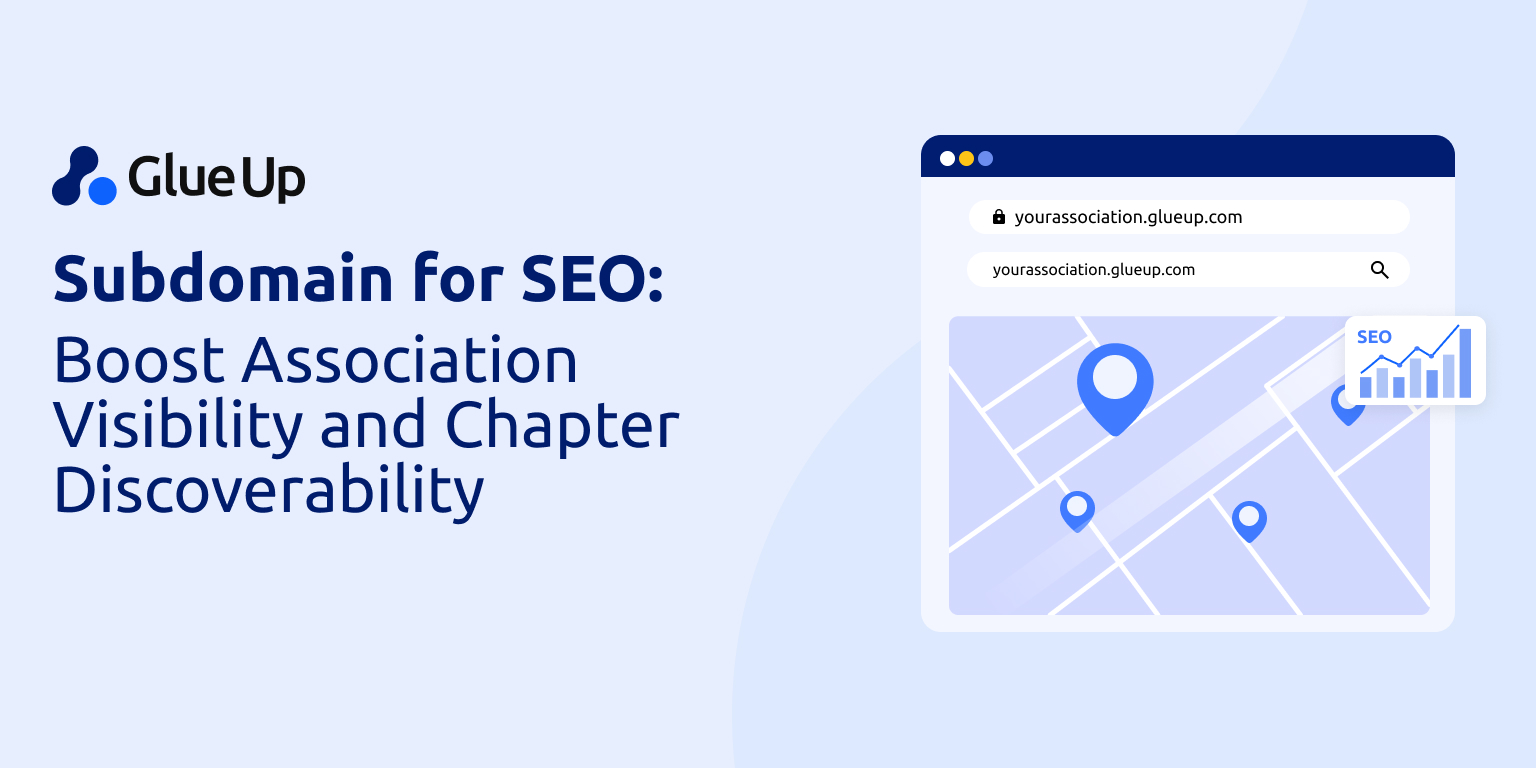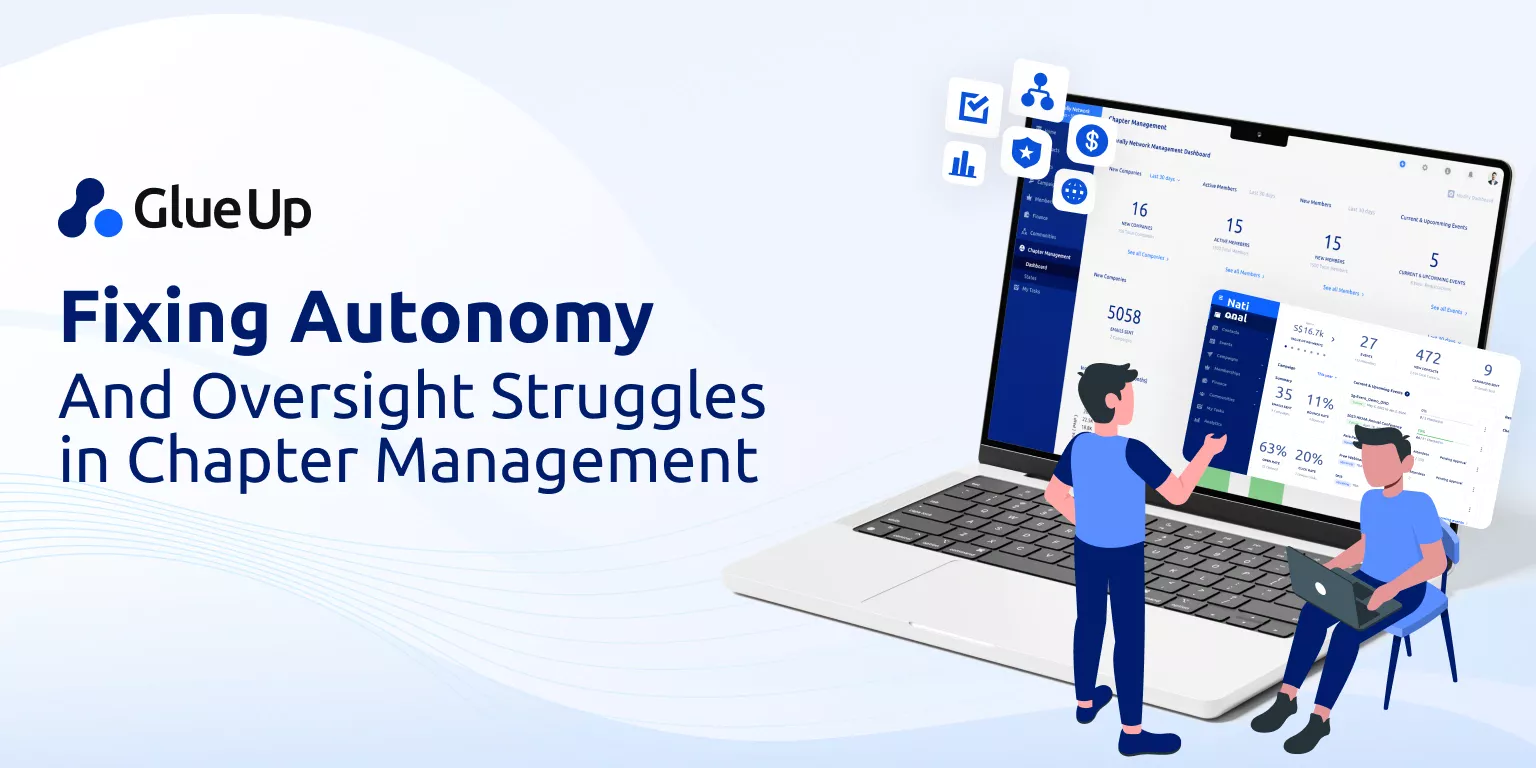
Your national association site is strong. The homepage ranks. Your webinars show up on Google. But when someone in Atlanta types “Atlanta construction trade group” into a search engine… your Atlanta chapter is nowhere to be found.
Not on page one. Not even on page five.
Why? Because it’s buried deep inside your main domain or hidden under a cluttered subdirectory like association.org/chapters/atlanta. Google doesn’t see it as its trusted source, so it doesn’t show it.
The fix? A dedicated subdomain for SEO.
It’s the unlock associations that they didn’t know they needed. And if you’re already using Glue Up, it’s easier to activate than you think.
Why Subdomain for SEO Matters in Associations
Let’s start with the basics: a subdomain (like nyc.association.org) is treated by search engines as a separate website. That means it has its authority, its keywords, and its chance to rank independently of your main site.
Google’s John Mueller has confirmed that subdomains are evaluated as separate properties. That’s a big deal for associations with chapters trying to show up in local searches like “trade group in Denver” or “nonprofit networking in Cape Town.”
Right now, most member-based organizations bury local chapters under a complex URL structure like association.org/regions/southwest/phoenix. That’s hard for users to remember and harder for Google to crawl.
When chapters have their subdomain, they:
- Appear in localized search results
- Build trust with regional audiences
- Control their messaging, events, and updates
This isn’t theory. It’s SEO reality. Companies like HubSpot and Disney use subdomains to separate regions, brands, or functions, and it works. Associations can, too.
The Visibility Gains of Using Subdomains for Chapters
Let’s get specific. What do subdomains actually improve for your chapters?
Improved Local SEO
Subdomains help your chapters rank for geographic + keyword combinations, like “Dallas marketing association” or “Singapore trade council.” These are searches your national homepage won’t show up for, but your chapter subdomain can.
Stronger Local Identity
Instead of being hidden in a folder, chapters get a clear online home:
nyc.association.org → looks official, builds trust, and gives local teams pride of place.
Better Analytics
Subdomains make it easy to track performance by chapter. You’ll know which regions drive traffic, convert visitors, and effectively promote events.
Content Freedom
Each chapter can publish its blogs, member stories, and sponsor content, without risking duplication or conflicts on the main site.
Example:
Compare these two:
- association.org/chapters/nyc
- nyc.association.org
Which one looks more trustworthy to Google and your members? Exactly.
How Glue Up Helps You Launch and Manage Subdomains (Painlessly)
What is the biggest reason most associations don’t use subdomains? They think it’s too technical. DNS records, SSL certificates, redirects, it sounds like a lot. But not when you’re using Glue Up.
Here’s how Glue Up makes it easy:
Built-in Subdomain Setup
Dedicated subdomain creation is part of Glue Up’s chapter management tools. You don’t need a developer. Just let us know what you want, cityname.yourassociation.org, and we’ll take care of the rest.
Secure, Mobile-Ready, and SEO-Friendly
Each subdomain comes with:
- HTTPS/SSL by default
- Mobile responsiveness
- Crawlable structure and sitemap
- Schema markup support for better indexing
Local Analytics Built In
Chapters can access their dashboards, allowing them to track performance without interfering with the national data. Leadership can still monitor everything from the top.
Already Running Chapters? We’ve Got You
Glue Up can map and migrate your existing chapter pages to subdomains with minimal disruption. That includes preserving links, updating menus, and syncing content templates.
Best Practices for SEO With Subdomains
Subdomains unlock visibility, but only if you treat them like standalone sites. That means no copy-pasting and no half-finished pages.
Here’s how to get it right:
Follow these SEO basics
- Use a clear structure: e.g., miami.association.org, toronto.association.org
- Create original local content: Don’t duplicate blog posts or events from the national site
- Cross-link chapters and national site: Helps build authority and improves navigation
- Unique meta titles and schema: Tailor them to the chapter’s location and focus
- Local business listings: Sync each subdomain with Google Business and similar platforms
Glue Up Makes It Manageable
- Use CMS templates to help chapters build consistent content
- Allow chapters to edit pages while maintaining brand guidelines
- Customize metadata per chapter site
- Monitor SEO health with chapter-level analytics dashboards
This setup isn’t just smarter; it’s scalable. Chapters gain the independence they need, while HQ maintains control of branding and visibility.
When Subdomains Make Sense (And When They Don’t)
Subdomains aren’t a silver bullet. They’re ideal in some cases, not all. Here’s how to know what’s right for your structure.
When Subdomains Make Sense:
Use Case | Why It Works |
Chapters with their teams and marketing plans | Need local SEO, content freedom, and branding |
Events and members are region-specific | Easier to rank for city-based keywords |
Local sponsors and stories matter | Chapters need space to highlight them |
You want cleaner analytics per chapter | Subdomains keep tracking separated |
When Subdirectories Might Be Better:
Use Case | Why It Works |
Centralized content and team | Easier to manage under one domain |
Minimal chapter autonomy | One voice, one site |
Less focus on local SEO | Global or national strategy wins |
Glue Up supports both, but we recommend subdomains if your chapters want visibility and ownership without the hassle.
Not sure what’s best for your structure? We’ll walk you through it during onboarding or migration.
Real Results: Associations That Rank Better With Subdomains
When associations switch to subdomains, the difference is measurable and fast. Here are a few anonymized results from Glue Up clients using the subdomain feature:
- Before: All traffic flowed to the main association site. Local chapters had no visibility in regional search.
- After: Chapters got their subdomains (e.g., chicago.association.org), each with tailored content and branding.
The Outcomes?
- 5× increase in local event signups within 3 months
- 40% jump in regional newsletter click-through rates
- Stronger performance in location-based Google searches
- Better lead attribution and higher conversion from localized CTAs
Members didn’t just visit, they registered, donated, and showed up. Give your chapters the digital visibility they deserve. Your chapters already do the work. Subdomains make sure they get seen.



